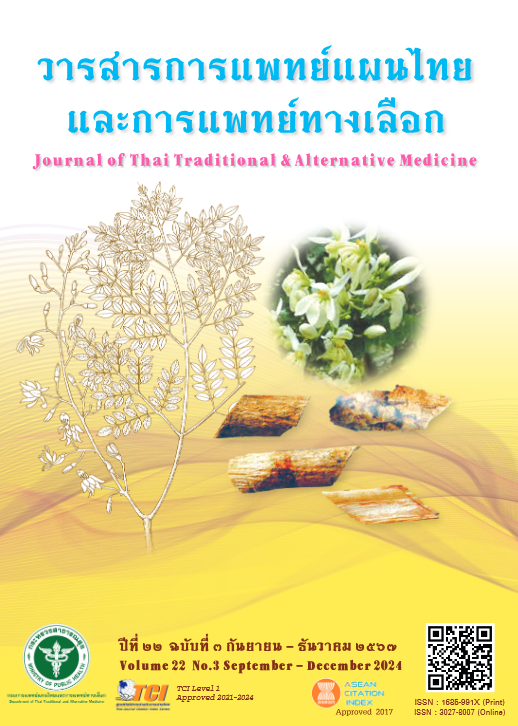Effectiveness of Hemorrhoids and Skin Disease Formula in Ayurveda Textbook of Khun Nittessukkit: A Case Study in Psoriasis Patients
Main Article Content
Abstract
Introduction and objective: Psoriasis is a condition that affects people of all genders and ages. Currently, there is no definitive cure for the illness, and treatments are only available to alleviate symptoms. The hemorrhoids and skin disease formula (HSDF) in Ayurveda Textbook of Khun Nittessukkit, a Thai traditional medicine text, had properties for the treatment of skin conditions. Given its usage in Thai traditional medicine, the researchers were interested in studying the effectiveness of the HSDF for treating psoriasis patients.
Methods: The screening process involved selecting participants diagnosed with mild to moderate psoriasis by modern medical practitioners. A total of 40 participants were chosen and divided into two groups: the experimental group of 20 participants received HSDF and the control group of 20 participants received a 0.1% TA steroid cream. The participants were randomly assigned to each group. Treatment follow-up was done every 2 weeks for a total duration of 6 weeks. The effectiveness was evaluated using the Psoriasis Area and Severity Index (PASI) and the Dermatological Quality of Life Index (DLQI) questionnaires. Statistical methods employed included frequency, mean, percentage, standard deviation, and the comparison of skin conditions before and after the intervention using the paired t-test.
Results: The PASI severity levels (in mean scores) from the follow-up of the experimental and control groups before and after the trial were found to significantly decrease (p < 0.001). The DLQI assessment of skin disease patients in the experimental group showed a slight improvement in quality of life; the low level before treatment (mean = 2.44, SD = ± 0.46) and the low level after the trial (mean = 1.83, SD = ± 0.45). The control group had a moderate DLQI before treatment (mean = 2.59, SD = ± 0.19) and a low DLQI after the trial (mean = 2.09, SD = ± 0.22). No adverse effects were observed in either group regarding safety.
Discussion: The HSDF in Ayurveda Textbook of Khun Nittessukkit demonstrated efficacy in the treatment of psoriasis patients, compared to the treatment with 0.1% TA steroid cream. The treatment regimen involved bi-weekly follow-ups over a period of six weeks. The assessment of psoriasis severity before and after the trial showed improvement, and the patients’ quality of life also improved. This included reductions in stress related to the illness and enhancements in psychological and social well-being. In terms of safety, no adverse effects were observed in either group.
Conclusion and recommendations: This study provides evidence that supports the use of the HSDF, potentially offering a treatment alternative for physicians, traditional Thai medicine practitioners, and patients. Thus, it is recommended that further studies should be undertaken for developing the formulation to be more user-friendly and addressing the issue of turmeric stains on clothing to enhance its practicality for everyday use.
Article Details

This work is licensed under a Creative Commons Attribution-NonCommercial-NoDerivatives 4.0 International License.
References
Angkhawattanawit D. Psoriasis Chronic skin disease Must be free from disease. [Internet]. 2021 Jan [cited 2021 May 10]; 1(1): [14 screens]. Available from: https://www.rama.mahidol.ac.th/atrama/sites/default/files/public/pdf/column/@Rama11_E12.pdf.
Champathong P. Nursing care for patients with psoriasis (Psoriasis) case study. [Internet]. 2021 Jan [cited 2021 May 10]; 1(1): [14 screens]. Available from: https://ddc.moph.go.th/uploads/files/2085220210928134937.pdf.
Angkhawattanawit D. Psoriasis Chronic skin disease Must be free from disease. [Internet]. 2021 Jan [cited 2021 May 10]; 1(1): [14 screens]. Available from: https://www.rama.mahidol.ac.th/atrama/sites/default/files/public/pdf/column/@Rama11_E12.pdf.
Pathamadilok B. Psoriasis. [Internet]. 2021 Jan [cited 2021 May 10]; 1(1): [14 screens]. Available from: https://www.iod.go.th/wp-content/uploads/2020/10/news_29.pdf.
Pathamadilok B. Psoriasis. [Internet]. 2021 Jan [cited 2021 May 10]; 1(1): [14 screens]. Available from: https://www.iod.go.th/wp-content/uploads/2020/10/news_29.pdf.
Division of Medical Practice. Scriptures with Kuttha. In general traditional medicine textbooks Thai Medicine, Volume 2. Bangkok: Cooperative Assembly Press of Thailand. 1998: 32-35.
Royal Gazette. (2019). Announcement of the Ministry of Public Health regarding the designation of a category 5 narcotic formula that contains marijuana that can be consumed for disease treatment or research. 2019. In Lem. 136, special section 94 D ( p. 27).
Riaz T., Iqbal M.W., Mahmood S., Yasmin I., Leghari A. A., Rehman A., Mushtaq A., Ali K., Azam M., and Bilal M. (2023). Cottonseed oil: A review of extraction techniques, physicochemical, functional, and nutritional properties. Critical reviews in food science and nutrition, 63(9), 1219–1237. https://doi.org/10.1080/10408398.2021.1963206
KumarM., Zhang B., Potkule J., Sharma K., Radha R., Hano C., Sheri V., Chandran D., Dhumal S., Dey A., Rais N., Senapathy M., Natta S., Viswanathan S., Mohankumar P. and Lorenzo J.M. Cottonseed Oil: Extraction, Characterization, Health Benefits, Safety Profile, and Application. Food Anal. Methods 16, 266–280 (2023). https://doi.org/10.1007/s12161-022-02410-3
Keen, Mohammad Abid; Hassan, Iffat. Vitamin E in dermatology. Indian Dermatology Online Journal 7(4): p 311-315, Jul–Aug 2016. https://doi.org/10.4103/2229-5178.185494
Salimath S.S., Romsdahl T.B., Konda A.R., Zhang W., Cahoon E.B., Dowd M.K., Wedegaertner, T.C., Hake K.D. and Chapman K.D. (2021). Production of tocotrienols in seeds of cotton (Gossypium hirsutum L.) enhances oxidative stability and offers nutraceutical potential. Plant biotechnology journal, 19(6), 1268–1282. https://doi.org/10.1111/pbi.13557
Liu X., Yang G., Luo M., Lan Q., Shi X., Deng H., Wang N., Xu X. and Zhang C. (2021). Serum vitamin E levels and chronic inflammatory skin diseases: A systematic review and meta-analysis. PloS one, 16(12), e0261259. https://doi.org/10.1371/journal.pone.0261259
Pandey A., Shukla A.K., Dubey R.C. and Pratap R. (2021). A review on the important phytochemicals and their role in psoriasis. Journal of Applied and Natural Science, 13(3), 880 - 896. https://doi.org/10.31018/jans.v13i3.2717
Zhang S., Wang J., Liu L., Sun X., Zhou Y., Chen S., Lu Y., Cai, X., Hu M., Yan G., Miao X., and Li, X. (2022). Efficacy and safety of curcumin in psoriasis: preclinical and clinical evidence and possible mechanisms. Frontiers in pharmacology, 13, https://doi.org/10.3389/fphar.2022.903160
Chamroen B. The Stress Management Experiences of Psoriasis Patients. Health Promotion Management Faculty of Public Health Thammasat University 2017: 58-59. https://ethesisarchive.library.tu.ac.th/thesis/2017/TU_2017_5417030235_3028_6917.pdf.


